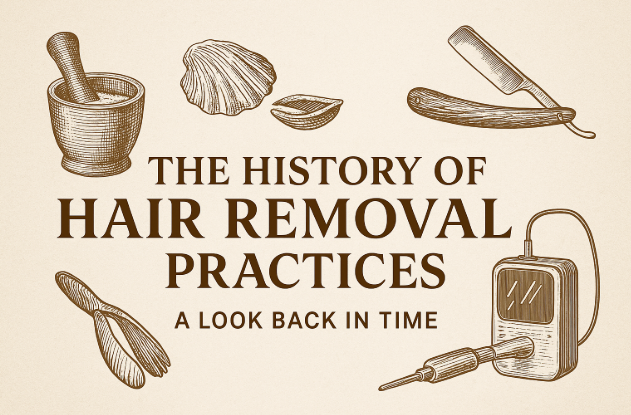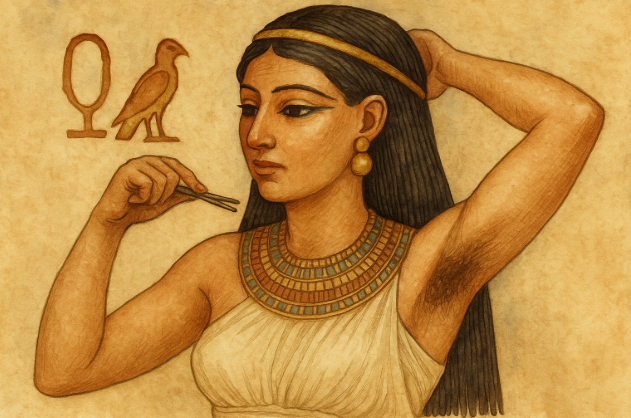“The History Of Hair Removal Practices | A Look Back In Time” covers a period from seashell tweezers in ancient Egypt to high-tech lasers in modern clinics.

Hair removal has long been a reflection of beauty ideals, cultural norms, and even power dynamics. Whether to please gods, gain social favor, or simply keep up with trends, people across centuries have gone to great lengths—sometimes literally painful ones—to remove unwanted hair.
In this article, we’ll take a fascinating journey through time to uncover how hair removal practices evolved and what they reveal about the societies that embraced them.
Hair Removal Frenzy | Where Did It All Start?
Nowadays, it seems like nearly everyone is caught up in the quest to be smooth and hair-free. We see salons offering a multitude of hair removal services. Meanwhile, advertisements for razors and creams fill the shelves and screens.
But have you ever paused to think about why we’re so obsessed with getting rid of body hair? It seems almost ingrained in our culture.
Before we get too caught up in modern trends, it’s worth exploring where it all started. The journey of hair removal is as old as civilization itself, intertwined with perceptions of beauty, status, and hygiene.
As we dig into history, we start seeing how the reasons for hair removal have evolved. Interestingly, it remained quite the same through the ages.
Body hair wasn’t just a stylistic concern in ancient times. It often served practical purposes, such as protection from harsh weather and environmental exposure. As societies began using clothing for warmth and shelter, body hair took on new significance. As such, it became associated with:
- Beauty ideals.
- Social status.
- And even religious customs.
Fast forward to today, and we’re living in an era that’s both obsessed with hair removal and increasingly embracing body positivity and personal choice. For many, removing body hair is about feeling clean or sexy, while others see it as a simple grooming habit.
The reasons vary widely, highlighting an ever-evolving dialogue about cultural norms and individual identity.
From Cleopatra to Caesar | Ancient Civilizations’ Hair Removal Techniques
The fascination with smooth, hair-free skin stretches back thousands of years. Ancient Egyptians probably took the cake when it came to beauty rituals. They celebrated smooth skin as a symbol of purity and youth.
Their toolkit for these rituals included techniques like sugaring, where a sticky paste made from sugar was used to yank hairs out, and improvised tweezers fashioned from seashells. Even the Pharaohs weren’t above using early razors, crafted from flint, which speaks volumes about the importance placed on this practice.
Meanwhile, across the Mediterranean, the Greeks and Romans took hairlessness to a whole new level. For them, a hairless body wasn’t merely about beauty—it signified higher social status and morality.
In Roman bathhouses, body hair was meticulously removed, often using pumice stones or the ever-popular depilatory creams mixed from natural ingredients.
Not to be outdone, Middle Eastern civilizations introduced threading and halawa as staple techniques.
- Threading involves skillfully twisting a thread to trap and remove unwanted hair.
- Meanwhile halawa, similar to sugaring, used caramelized sugar mixtures to achieve the same result.
These methods have stood the test of time, remaining popular in many cultures even today.
Understanding these practices offers more than a peek into ancient beauty routines. It gives us insight into the cultural significance that shaped societal norms around beauty and cleanliness. These are roots worth recognizing in today’s context of personal grooming.
While hair removal is primarily about aesthetics now, ancient methods remind us of their varied significance—social, cultural, and even spiritual.
The key takeaway from these practices is variety—we have countless methods and tools to choose from, reflecting diverse traditions and discoveries. When considering your own grooming habits, embrace what works best for you, keeping in mind the long history and cross-cultural significance of these techniques.

European Evolution | Medieval to Renaissance Hair Removal Practices
As we step into medieval and Renaissance Europe, the scene around hair removal shifts quite dramatically. Consider the turn from the open displays of classical beauty to the more modest and subdued tones of medieval society.
This meant hair removal wasn’t always about flaunting but more about cleanliness and religious propriety.
Interestingly, religious doctrines played a significant role in shaping grooming habits. Hair, particularly body hair, was seen through the lens of sin and virtue. Despite restrictions, people found ways around these challenges, often involving clever and somewhat rudimentary methods.
Women of the Middle Ages made use of whatever was available to achieve the desired smoothness. Pumice stones were common, used to rub off hair albeit with a fair dose of discomfort.
Early depilatory creams, mixed from harsh ingredients like quicklime, were recipes passed down through generations, embodying an intriguing mix of desperation and ingenuity.
As the Renaissance awakened a new focus on art and the human body, shifting aesthetics started to bring grooming back into the limelight. Body hair was more strategically managed, influenced by the paintings and sculptures of that era depicting clean, idealized forms.
Tracing the evolution of medieval to Renaissance grooming offers us perspective. It was a world where despite limited resources and societal rules, people sought to express beauty and upkeep. Subsequently, they crafted methods that were as much about tradition as they were about aesthetics.
For anyone looking into hair removal today, the diversity of methods—from pumice to cream—is a nod to creativity and persistence. It reminds us that while the tools and reasons might have evolved, the quest for individual expression through grooming has always been around.
Choosing what suits you best among modern solutions should feel less daunting with this rich historical backdrop in mind.
Industrial Shift | Cultural Changes from the 18th to 19th Century
The 18th century marked a notable shift in grooming practices with the industrial revolution driving innovations that transformed personal care tools.
Men’s grooming habits took center stage first, with the invention of the safety razor by Jean-Jacques Perret. It revolutionized shaving by making it safer and more accessible than ever before. The jump in men’s grooming inevitably paved the way for women to adopt razors, albeit at a slower pace.
This period also saw beauty standards evolve among the upper class in Europe. Hairlessness became more than just a personal choice—it was an indicator of wealth and sophistication.
For ladies of leisure, achieving a smooth complexion was almost an art form. Subsequently, they became reliant on newly developed products like more sophisticated depilatory creams and powders. These promised ease and effectiveness.
The widespread adoption of these grooming habits wasn’t just about fashion; it reflected changing societal norms. With the rise of printed fashion plates and societal gatherings, appearances became more scrutinized.
For women, being hair-free implied not only cleanliness but also adherence to the societal ideals of femininity and grace.
Reflecting on this era’s innovations reminds us of how technology can reshape everyday habits, even ones as personal as hair removal. The progression towards safer, more effective grooming tools made personal care accessible and varied.
Exploring these roots may help guide choices today, prompting a deeper appreciation for the products and methods we now have. Choosing the right grooming method becomes less about obligation and more about personal comfort and preference.

Technological and Cultural Revolution | The 20th and 21st Centuries
The 20th century kicked off a whirlwind of change for hair removal practices as modern fashion started influencing grooming standards. In 1915, Gillette launched its first razor for women, targeting underarm hair along with the growing trend of sleeveless dresses.
The shift in clothing preferences prompted a whole new focus on visible smooth skin, steering public opinion towards hair-free beauty.
As the decades rolled on, the influence of Hollywood and fashion magazines further entrenched hairlessness as a desirable trait. As such, it sparked widespread adoption of new methods like waxing and electrolysis.
By the mid-20th century, bikinis ushered in another transformation, bringing bikini waxing into the mainstream and further cementing the connection between beauty and body hair.
The arrival of the 21st century brought technological advances to unprecedented heights. Laser hair removal and intense pulsed light (IPL) treatments promised longer-lasting solutions. Furthermore, these advancements not just alter methods but our approach to body hair altogether.
For many, these technologies offer a balance between efficiency and longevity, reflecting ongoing shifts in beauty ideals.
These decades also invited more diverse conversations around body positivity and inclusivity. While smooth skin remained popular, more people began embracing natural body hair, challenging traditional norms and celebrating personal choice and identity.
Meanwhile, many ancient techniques like sugaring and threading have enjoyed a resurgence, proving that the past still holds valuable lessons and techniques.
In journeying through the current era, understanding these historical shifts can offer a guiding light in making informed personal grooming choices.
It’s essential to appreciate the blend of technology, heritage, and cultural shifts that shape our grooming habits today. It leaves the door open for both time-tested and innovative methods. At the heart of it all is the freedom to choose what feels best, rooted in an understanding of how far we’ve come.
Conclusion | The History of Hair Removal Practices
Key Takeaways:
- Hair removal has never been just about aesthetics—it has always told a deeper story.
- Whether shaped by religion, class, fashion, or personal preference, the ways we manage body hair reflect the changing tides of history.
- As we continue to redefine beauty and embrace more inclusive standards, it’s empowering to know that the choice to remove (or not remove) hair can be deeply personal rather than purely cultural.
- Looking back shows us just how far we’ve come—and how much freedom we now have to decide what’s right for ourselves.
What methods have you tried? Have cultural traditions or personal beliefs shaped your views on hair removal?
Share your story or ask a question in the comments below. Your voice adds to the ongoing conversation—and someone else might benefit from your experience.
Veron | Business Owner | The Way 4Word Enterprises